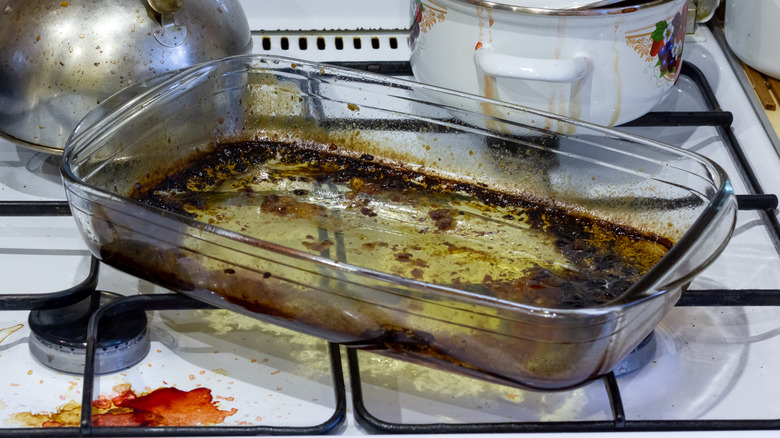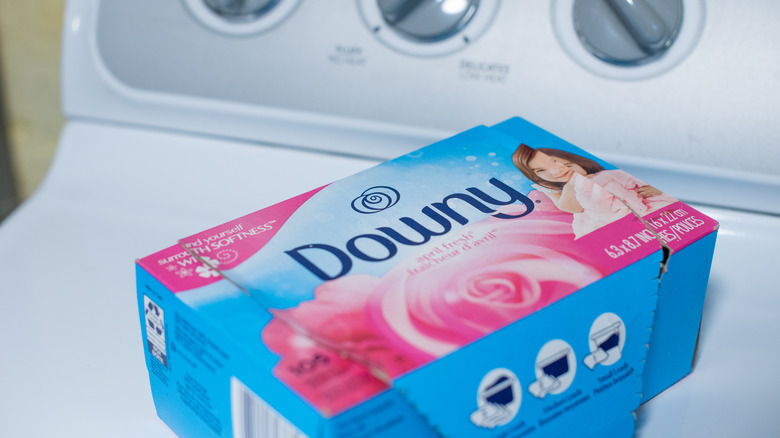The Unexpected Laundry Item That Takes Care Of Baked On Pyrex And Bakeware Stains
Pyrex bakeware, renowned for its durability and resistance to temperature changes, can still develop stains and caked-on debris from food over time. Despite its non-porous nature, microscopic scratches or imperfections in the glass surface can trap food particles, oils, and pigments from various ingredients. Over repeated use and exposure to heat, these particles can adhere to the surface and become embedded, leading to discoloration and stains. Additionally, certain foods containing acidic or heavily pigmented components, such as tomato-based sauces or spices like turmeric, can cause more noticeable staining due to their ability to penetrate the glass surface or the plastic lids. One solution to remove these stains easily is using a dryer sheet that you likely already have at home.
Dryer sheets, commonly used in laundry to reduce static cling and impart a fresh scent to clothes, can surprisingly aid in the removal of stains from Pyrex bakeware. The softening agents and surfactants present in dryer sheets possess mild abrasive properties that can help dislodge stubborn food stains without damaging the glass surface. When combined with warm water and gentle scrubbing, the texture and chemicals of dryer sheets loosen and lift food residues and pigments from the pores and scratches in the Pyrex glass. Moreover, the fragrances found in dryer sheets often contain compounds that can help neutralize odors, leaving the bakeware smelling fresher after cleaning. Therefore, this dryer sheet hack offers a simple yet effective and affordable solution for cleaning your stained or dirtied Pyrex bakeware.
How to clean your Pyrex with a dryer sheet
To remove baked-on food stains from your Pyrex using a dryer sheet, begin by filling the stained bakeware with warm water. Drop a clean dryer sheet into it and allow it to soak for at least 15 to 30 minutes to loosen the food particles and make them easier to remove. After soaking, drain the water and inspect the bakeware for any remaining stubborn stains. Next, take a clean sponge and dampen it slightly with water. Scrub the Pyrex, focusing on areas with visible residue or discoloration. The softening agents and surfactants in the dryer sheet should have worked to lift and dissolve the baked-on food stains from the glass surface. Repeat the process as necessary until the stains are noticeably reduced or removed entirely.
Once the stains have been sufficiently treated, rinse the Pyrex thoroughly with clean water to remove any remaining residue. Inspect the bakeware to ensure all stains have been removed to your satisfaction. If any stubborn stains persist, consider repeating the process or using alternative cleaning methods such as baking soda paste or vinegar solution. Finally, dry the Pyrex with a clean towel or let it air dry completely before storing or using it again. Dispose of the used dryer sheet appropriately, and avoid using the same dryer sheet for other cleaning tasks to prevent cross-contamination of food residues. In just a short amount of time, your Pyrex should be as good as new!
Cautions for using this method
While using dryer sheets to clean Pyrex bakeware can be effective, it's important to be cautious due to the chemicals present in these sheets. Dryer sheets contain a variety of ingredients, including fragrances, softening agents, and surfactants, which may not be intended for direct contact with food-contact surfaces like Pyrex. One concern is the presence of synthetic fragrances in dryer sheets, which can contain a mixture of chemicals, including phthalates and volatile organic compounds. These chemicals may leave residues on the Pyrex surface after cleaning, potentially transferring to food items during cooking or storage. While the concentrations are typically low, repeated exposure to these chemicals over time could raise health concerns, especially for individuals sensitive to fragrance or those with allergies.
Additionally, some dryer sheets contain softening agents such as quaternary ammonium compounds, which are known for their antimicrobial properties. While quats can help remove stains and odors, they may leave behind residues that could come into contact with food. Prolonged exposure to quats may lead to potential health risks, particularly if ingested or absorbed through the skin. Moreover, the surfactants in dryer sheets, which help break down stains and grease, may not be food-safe. These surfactants can leave residues on the Pyrex surface, posing a risk of contamination if they come into contact with food. While most dryer sheets are designed for use in laundry and not explicitly tested for food-contact surfaces, their chemical composition raises concerns about their suitability for cleaning cookware.

